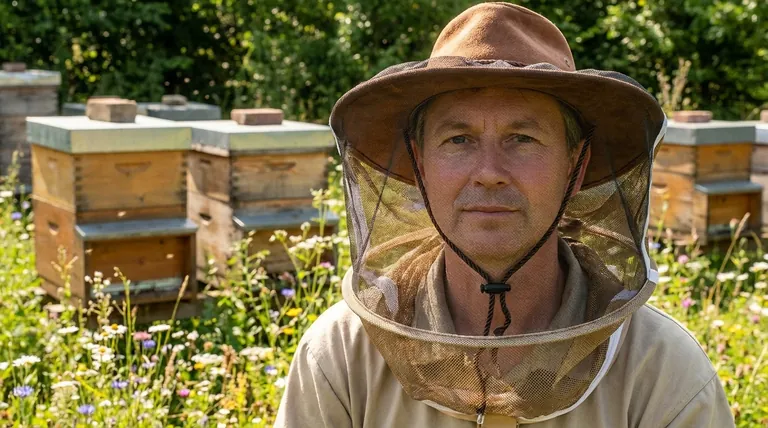Ultimately, the most important factor in choosing a beekeeping veil is the one that guarantees you will actually wear it every single time. While different designs offer unique benefits, a veil's effectiveness is zero if it's left in the shed because it's uncomfortable or difficult to use. It must provide a secure balance of protection and comfort that matches your confidence level.
The best veil is not defined by a single feature, but by its ability to become an invisible, reliable barrier. For a beginner, this means prioritizing absolute, gap-free protection, while for an experienced keeper, it might mean maximizing visibility and comfort for long days in the apiary.

Why the Veil is Non-Negotiable
A quality veil is the most critical piece of protective equipment you will own. Understanding its core purpose frames every other decision.
The Head is the Primary Target
Bees instinctively target the face and head area when they feel threatened. A sting near the eyes, nose, or mouth is not only painful but can be particularly dangerous, making a reliable veil an absolute necessity for safety.
Confidence Through Protection
A secure veil allows a beekeeper to remain calm and focused, even when surrounded by bees. This confidence is crucial, as calm, deliberate movements are less likely to agitate the colony, leading to a safer and more productive experience for both you and the bees.
Deconstructing the Main Veil Types
Your experience level and personal preference will guide you toward one of three primary designs.
The Fencing Veil (The Fortress)
This is the most popular style, especially for beginners. The design features a structured mesh that stands away from the face like a fencer's mask, often supported by integrated wiring.
Most importantly, fencing veils are commonly designed to zip directly onto a beekeeping jacket or full suit. This creates a virtually impenetrable seal, eliminating the risk of a bee finding a gap around your collar.
The Round Veil (The Classic)
This traditional style offers excellent, 360-degree peripheral vision. It is essentially a brimmed hat draped with mesh that is held away from the face on all sides.
While the visibility is a major benefit, it must be worn carefully over a collared shirt or jacket and secured with a drawstring to prevent bees from crawling underneath.
The Square Veil (The Hybrid)
As the name suggests, this veil has a square or rectangular shape, with mesh panels on the front and sides. It offers a good compromise between the protection of a fencing veil and the packability of a simpler design, as it often folds flat for easy storage.
Understanding the Trade-offs
Choosing a veil involves balancing competing priorities. Being aware of these trade-offs is key to making an informed decision.
Protection vs. Visibility
A fully-zipped fencing veil offers maximum protection against intrusion. A round veil, however, provides superior, unobstructed peripheral vision which some experienced beekeepers prefer for spotting hive activity.
Integration vs. Flexibility
A veil that zips to a suit is a single, secure system. A separate, standalone veil and hat offer more flexibility to mix and match gear, but it requires more diligence from the beekeeper to ensure there are no gaps where the veil meets the shirt collar.
Comfort vs. Security
The best veil is one that stays securely in place without feeling restrictive. Look for features like reinforced brims to keep the mesh off your face and elastic straps or drawstrings that keep the veil anchored to your shoulders or chest without being too tight.
Making the Right Choice for Your Goal
Your primary objective in the bee yard should guide your selection.
- If you are a beginner focused on safety: Choose a fencing veil that zips directly to a dedicated beekeeping jacket or suit. This eliminates guesswork and provides the most secure protection.
- If your primary focus is maximum visibility and airflow: A traditional round veil is an excellent choice, provided you are diligent about ensuring it is properly secured over your collar every time.
- If you need a portable option for quick inspections: A standalone square or fencing veil offers a good balance, but always perform a careful check for gaps before you approach a hive.
Ultimately, the right veil is the tool that allows you to work with your bees calmly and confidently.
Summary Table:
| Veil Type | Best For | Key Features |
|---|---|---|
| Fencing Veil | Beginners, Maximum Protection | Zips to suit, structured mesh, gap-free seal |
| Round Veil | Experienced Keepers, Visibility | 360° peripheral vision, traditional design |
| Square Veil | Portability, Quick Inspections | Hybrid design, folds flat for storage |
Ready to choose the perfect veil for your apiary?
At HONESTBEE, we understand that the right protective gear is fundamental to a safe and productive beekeeping operation. We supply commercial apiaries and equipment distributors with high-quality, durable beekeeping veils and suits designed for comfort and maximum security.
Let us help you equip your team with confidence. Contact our wholesale experts today to discuss your specific needs and explore our full catalog of reliable beekeeping supplies.
Visual Guide

Related Products
- Heavy Duty Cowboy Beekeeper Hat with Visibility Veil Outdoor Professional Beekeeping Protective Gear
- Beekeeper Cowboy Hat and Veil for Beekeeping
- Square Folding Bee Hat Veil with String for Beekeeping
- Professional Beekeeping Suit for Kids and Girls Childrens Bee Keeper Suit
- Yellow Plastic Bucket Pail Perch for Beekeeping
People Also Ask
- What features enhance the quality of the beekeeping veil? Choose the Right Protection for Your Apiary
- What activities is the beekeeping hat suitable for? Beyond the Hive for Ultimate Outdoor Protection
- Why are a hat and veil considered the most important parts of beekeeping protective gear? Essential Protection for Your Face and Confidence
- How can beekeeping supplies and accessories enhance the hobby? Essential Tools for Safe & Rewarding Beekeeping
- What is the purpose of a hat and veil in beekeeping? Essential Protection for Head & Face



















